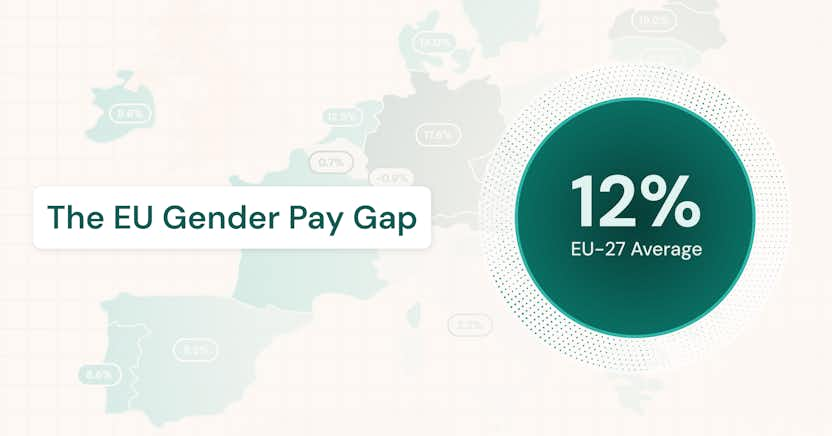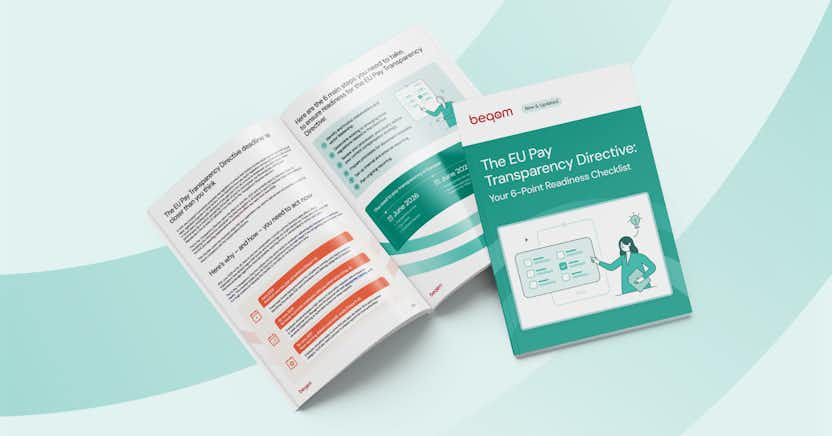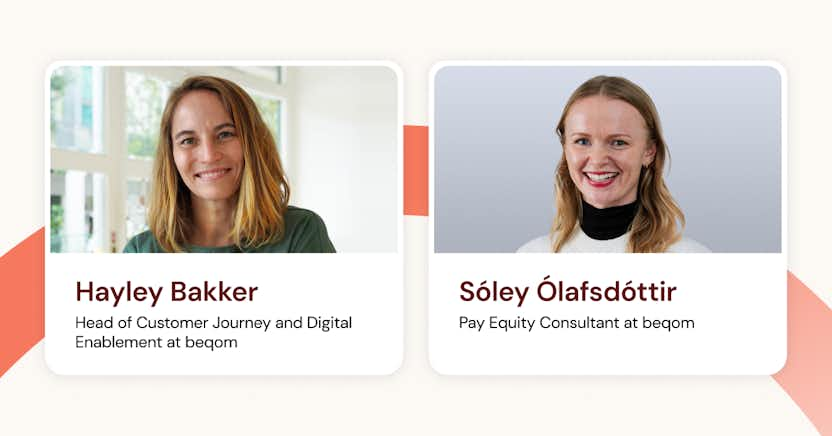Always-On Pay Equity

Learn more about the following beqom products
As pay equity becomes increasingly important to organizations, HR leaders are beginning to recognize the need for a deeper approach that goes beyond traditional one-time pay equity audits. Because decisions about compensation are made continuously throughout the year, and those pay decisions can affect the company’s equal pay strategy and pay gaps, the concept of "always-on" pay equity is emerging as a strategic imperative.
How can HR practitioners embed pay equity software into their ongoing processes? Beyond the mere identification of pay gaps, how can companies foster a data-driven culture that informs decisions with pay equity strategy at every touchpoint of the employee journey?
A continuous, intentional approach to pay equity is essential, and technology can play a pivotal role in this transformative journey.
Understanding the pay equity landscape
To define a pay equity strategy, it's first important to distinguish between adjusted and unadjusted pay gaps, two measures used to analyze wage disparities between different groups within a workforce, typically categorized by gender, ethnicity, or other demographic factors.
The unadjusted pay gap, also called “raw “or “uncontrolled”, represents the overall difference in average earnings between two or more groups without accounting for any factors that could explain a difference in compensation other than being in a certain group. When people talk about the gender pay gap, such as women earning 83 cents for every dollar earned by men, they are often talking about the unadjusted gap. Overall women earn less than men, but the unadjusted gap does not tell us whether that is because they are not receiving equal pay for equal work, or whether other factors are in play.
The adjusted pay gap factors in relevant variables, such as job role, education, experience, and other attributes, to determine if there is a wage disparity that cannot be explained by such factors. This is also referred to as the "controlled pay gap". The adjusted pay gap seeks to isolate and quantify any remaining wage disparity that may indicate potential discrimination or bias. By controlling for factors that could legitimately influence pay differences, it provides a more nuanced and context-aware understanding of whether observed wage gaps are likely due to systemic issues.
For HR leaders adopting an always-on approach to pay equity, comprehending both gaps is imperative. The adjusted pay gap guides efforts to ensure equal pay for equal work, reflecting the organization's commitment to eradicating bias. Simultaneously, the unadjusted pay gap sheds light on systemic issues, such as disparities in promotions, career development, or job offers.
At the intersection of technology and HR strategy, having the right compensation management and pay equity software can empower HR leaders to effectively discern pay gaps. Utilizing advanced technology, which offers real-time workforce analytics and in-depth insights, enables a granular understanding of pay equity dynamics. This, in turn, facilitates data-driven decision-making. As organizations navigate the complexities of the pay equity landscape, addressing both adjusted and unadjusted gaps becomes fundamental to fostering a truly equitable work environment.
Beyond the audit: the “always-on” approach
While the one-time pay equity audits and remediation efforts serve as a starting point, they are only fixing a past problem, not preventing the problem from recurring. Decisions affecting compensation are made every day in job offers, promotions, merit increases, bonuses, and so on. And, decisions that affect an employee’s career track also can have a bearing on pay equity as those actions (or lack of them) can drive the underlying factors that determine pay. HR leaders need to transition from a reactive stance to a proactive, continuous approach that adapts to the dynamic nature of compensation and organizational structures.
An always-on approach is not merely about addressing pay gaps once they are identified but weaving equity considerations into the fabric of decision-making. It recognizes that the employee journey involves multiple touchpoints, from initial job offers to promotions to education and self-improvement efforts, each presenting opportunities to reinforce pay equity principles.
At the core of this shift is the understanding that technology plays a pivotal role. The software that drives compensation processes should facilitate continuous monitoring, providing real-time insights into compensation structures and flagging potential discrepancies at the moments that matter, when day-to-day decisions are being made. This proactive stance not only ensures compliance but also contributes to a culture of fairness, aligning every pay decision with the overarching goal of pay equity.
A culture of pay equity goes beyond the routine; it's a mindset that fosters a workplace where equity is not an afterthought but a guiding principle in every compensation and career decision.
Embedding pay equity in job offer decisions
In the realm of pay equity, the journey begins with the initial job offer. To cultivate a truly equitable workplace, HR leaders must consider the impact of these foundational decisions on long-term compensation dynamics. An always-on approach necessitates a shift from traditional negotiation models to data-driven methodologies that align with job architecture and pay scales.
Compensation management software can help HR leaders integrate real-time data insights into offer negotiations. This not only ensures that starting salaries are competitive and fair but also align with broader compensation principles. By anchoring decisions in job architecture and pay scales, organizations fortify their commitment to equitable practices right from the start of an employee's journey.
Role of job architecture and pay scales
Establishing a foundation for fair pay requires a systematic and well-defined approach to job architecture and pay scales. In the realm of ongoing pay equity, these components serve as guiding frameworks, supporting consistency and transparency in compensation decisions.
Job architecture as the foundation
Job architecture provides the structure for roles within an organization. In an always-on approach, HR leaders should evaluate and refine job architecture to align with company objectives and the pay equity strategy. This involves clearly defining roles, responsibilities, and expectations, setting the stage for equitable compensation across the organizational hierarchy.
Utilizing pay scales for consistency
Pay scales offer a structured framework for determining compensation levels based on factors such as experience, skills, and responsibilities. In the ongoing pursuit of pay equity, HR leaders should leverage pay scales as a reference point, ensuring that compensation decisions align with established norms.
Technology aids this process by providing real-time comparisons against industry standards and internal benchmarks. Utilizing software with these capabilities allows organizations to adjust pay scales dynamically, responding to market trends and maintaining pay transparency and equity. The integration of technology ensures that pay scales are not static documents but living guides that adapt to the evolving landscape of compensation, promoting fairness at every stage.
Ensuring alignment with pay equity principles
As HR leaders navigate the intricacies of job architecture and pay scales, the overarching goal should be to ensure alignment with pay equity principles. This involves not only scrutinizing individual roles but also evaluating the overall structure for potential biases. The always-on approach recognizes that a well-designed job architecture and pay scale system acts as a safeguard against inequitable compensation practices, contributing to a workplace where fairness is ingrained in every aspect of compensation decision-making.
Assessing equity in performance improvement processes
Beyond the realm of compensation figures, the journey towards pay equity encompasses the broader spectrum of employee development, where feedback, coaching, and training play pivotal roles.
The trajectory of an employee's career is significantly influenced by promotions, making them a pivotal factor in the larger context of pay equity. An always-on approach recognizes that promotions are not isolated events but continuous opportunities to reinforce and validate equitable compensation practices.
Promotions are influenced by performance reviews, which in turn may be influenced by goals, peer feedback, and manager coaching. Feedback, coaching, and training are not only tools for skill enhancement but also gateways to advancement. In the context of ongoing pay equity, HR leaders need to recognize the influential role these elements play in an employee's journey and ultimately their compensation.
Lack of access to constructive feedback or developmental opportunities can inadvertently contribute to disparities in promotions and subsequent compensation. Employees that do not receive much feedback have less of a chance of improving and advancing. The always-on equity mindset means ensuring that these developmental processes should be accessible to all employees, irrespective of gender, ethnicity, or other factors.
How a performance management system can support pay equity
A performance management system that facilitates widespread peer feedback and supports effective coaching by managers across the organization creates a foundation for employee growth and improvement, helping those with potential to advance. And when employees have clear goals that align with corporate objectives, that also enhances their ability to contribute and make a mark in the organization. Effective goal-setting and performance evaluations therefore also can help talented employees progress to higher positions and compensation levels based on merit.
When advancement occurs on a level playing field, groups that traditionally have been under-represented have a better chance of progressing their careers, thereby pre-empting pay gaps at the source. A continuous performance management system can help to make that possible.
Expanding data-driven decision-making
A shift towards data-driven decision-making is paramount for fostering continuous pay equity. Beyond periodic audits, HR leaders must embrace technology to harness real-time data insights, enabling a more proactive and responsive approach to compensation dynamics.
The always-on methodology thrives on a holistic, data-centric approach. HR practitioners should encourage a culture where decisions regarding compensation are informed by a comprehensive set of data points. This involves leveraging advanced compensation and pay equity management capabilities that provide root cause analysis and real-time analytics, allowing for a nuanced understanding of compensation structures, patterns, and potential biases.
Continuous monitoring and adjustment
An integral aspect of the always-on approach is the continuous monitoring and adjustment of compensation strategies based on evolving data insights. HR leaders should utilize technology not as a one-time solution but as an ongoing mechanism for refining compensation practices. This iterative process ensures that organizations remain agile and able to adapt to changes in the workforce and market dynamics.
Challenges and solutions in implementing always-on pay equity
Implementing an always-on pay equity approach is not without its complexities. Common challenges include resistance to change, articulating the business case to justify the investment, and potential pushback from existing organizational structures. HR leaders should anticipate these challenges to develop effective strategies for implementation and adoption.
Practical solutions for overcoming implementation hurdles
To overcome challenges, HR leaders can implement practical solutions. These may include robust change management strategies to address resistance, comprehensive training programs to upskill teams on new methodologies, and clear communication to mitigate potential pushback. The ROI of pay equity is clear, but an evaluation of the benefits and costs should be included in your business case for investing in the needed technology.
The iterative nature of the always-on approach
Recognizing that the always-on approach is iterative is crucial. Continuous improvement is inherent in this methodology, and HR leaders should emphasize this to their teams. Implementing feedback loops and regular assessments, and making adjustments based on evolving insights are integral components of sustaining an always-on pay equity approach.
A call to action for HR leaders
In the pursuit of an always-on pay equity approach, HR leaders are poised to usher in a new era of fairness and transparency in compensation decisions. This transformative methodology goes beyond the limitations of one-time audits, embracing continuous, data-driven processes that consider every touchpoint in the employee journey.
Throughout this exploration, we've highlighted the importance of understanding both adjusted and unadjusted pay gaps, the need to move beyond periodic audits, and the pivotal role of technology in facilitating ongoing pay equity efforts. The emphasis has been on embedding equity considerations at every stage, from job offers to promotions, creating a comprehensive and holistic approach.
The call to action for HR leaders is clear. Embrace the always-on mindset, where pay equity is not a standalone initiative but an integral part of the organizational ethos. Leverage the capabilities of technology not as a solution in itself but as a facilitator for creating a culture of fairness, high performance, low risk, and continuous improvement.
If you want to explore the transformative potential of pay equity and uncover the many benefits it can deliver to your organization, contact us at beqom to speak with a pay equity expert.








